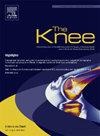第三个缺口--全膝关节置换术中被遗忘的空间
IF 2
4区 医学
Q3 ORTHOPEDICS
引用次数: 0
摘要
目的全膝关节置换术(TKA)的目的是使股骨近端凸缘与股骨皮质平齐。人工方法是通过股骨前皮质或髓内管找到必要的平面,而导航则是利用髋关节和膝关节中心。目前,没有任何系统优先考虑恢复第三空间或原生套骨沟高度(TGH),也没有关于TGH相对于股骨前皮质的变化的公开数据。本研究旨在解决这一不足。材料和方法相对于股骨后轴线,股骨前皮质的高度在外侧高于中央。结果TGH与股骨前皮质的差异平均为2.32毫米(标准差,SD 1.77毫米,范围-1.50毫米至6.80毫米)。如果假定股骨组件套管深度为 2.2 mm,那么 24.5% 的患者会出现超过或不足 2 mm 的情况。假设股骨组件套管深度为 2.2 毫米,则约有四分之一的患者(24.5%)会出现超过或不足 2 毫米的情况。股骨组件屈伸的不同,以及是否留有凹槽,都会增加进一步的差异。如果不能恢复第三间隙,很可能会导致 TKA 术后效果不理想。未来的手术流程应解决这一问题。本文章由计算机程序翻译,如有差异,请以英文原文为准。
The third gap – The forgotten space in total knee arthroplasty
Aims
Total Knee Arthroplasty (TKA) aims to leave the proximal flange of the femoral component flush with the femoral cortex. Manually, the requisite plane is found using the anterior femoral cortex or the intramedullary canal, whereas navigation uses hip and knee centre. Presently, no system prioritises restoration of the third space or native trochlear groove height (TGH) and there is a deficiency of published data on the variation of TGH with respect to the anterior cortex. This study aims to address this deficit. Hypothetically, restoration of the third space occurs when trochlear component depth equals TGH.
Materials and Methods
Relative to the posterior femoral axis the height of the anterior femoral cortex is higher laterally than centrally. For simplicity, this study reports MRI measurements of TGH relative to the centre in 110 normal subjects.
Results
TGH varied from the anterior femoral cortex by a mean of 2.32 mm (standard deviation, SD 1.77 mm, range −1.50 mm to 6.80 mm). If a femoral component trochlear depth of 2.2 mm is assumed, then 24.5% would be either over- or understuffed by more than 2 mm.
Conclusion
There is significant variation in TGH relative to the anterior femoral cortex. Assuming a femoral component trochlear depth of 2.2 mm, approximately one quarter of patients (24.5%) will be over- or understuffed by more than 2 mm. Variation in femoral component flexion and extension combined with whether or not it is left proud or notched will add further variation. Failure to restore the third space is likely to contribute to unsatisfactory results following TKA. Future surgical workflows should address this.
求助全文
通过发布文献求助,成功后即可免费获取论文全文。
去求助
来源期刊

Knee
医学-外科
CiteScore
3.80
自引率
5.30%
发文量
171
审稿时长
6 months
期刊介绍:
The Knee is an international journal publishing studies on the clinical treatment and fundamental biomechanical characteristics of this joint. The aim of the journal is to provide a vehicle relevant to surgeons, biomedical engineers, imaging specialists, materials scientists, rehabilitation personnel and all those with an interest in the knee.
The topics covered include, but are not limited to:
• Anatomy, physiology, morphology and biochemistry;
• Biomechanical studies;
• Advances in the development of prosthetic, orthotic and augmentation devices;
• Imaging and diagnostic techniques;
• Pathology;
• Trauma;
• Surgery;
• Rehabilitation.
 求助内容:
求助内容: 应助结果提醒方式:
应助结果提醒方式:


